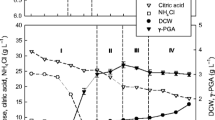Abstract
Poly(γ-glutamic acid) (PGA) production in Bacillus subtilis IFO3335 was studied. PGA was only slightly produced from medium (100 ml) containing 2 g citric acid and 0.5 g ammonium sulfate in B. subtilis IFO3335. When 0.01 g/100 ml l-glutamine was added to this medium, a large amount of PGA (0.45 g/100 ml), without any by-products such as polysaccharides, was produced. The changes in cell growth, and PGA, glutamic acid, citric acid and ammonium sulfate concentrations in this medium during cultivation were investigated. It was found that PGA was effectively produced for the short time of 20 h after an induction period and that glutamic acid was scarcely excreted during PGA production. PGA could be effectively produced using this medium containing l-glutamine, citric acid and ammonium sulfate. It is suggested that a small amount of l-glutamine added to the medium activated enzymes in the pathway of PGA synthesis in B. subtilis IFO3335. It can be presumed that the enzyme catalyzing the reaction from 2-oxoglutaric acid to l-glutamic acid was glutamate synthase in this bacterium.
Similar content being viewed by others
References
Borbely M, Nagasaki Y, Borbely J, Fan K, Bhogle A, Sevoian M (1994) Biosynthesis and chemical modification of poly(γ-glutamic acid). Polym Bull 32:127–132
Bovarnick M (1942) The formation of extracellular D(-)glutamic acid polypeptide by Bacillus subtilis. J Biol Chem 145:415–424
Cheng C, Asada Y, Aida T (1989) Production of γ-polyglutamic acid by Bacillus subtilis A35 under denitrifying conditions. Agric Biol Chem 53:2369–2375
Choi HJ, Kunioka M (1995) Preparation conditions and swelling equilibria of hydrogel prepared by γ-irradiation from microbial poly(γ-glutamic acid). Radiat Phys Chem 46:175–179
Fujii H (1963) On the formation of mucilage by Bacillus natto. Part III. Chemical constitutions of mucilage in natto (1). Nippon Nogeikagaku Kaishi 37:407–411
Giannos SA, Shah D, Gross RA, Kaplan DL, Mayer JM (1990) The biosynthesis of unusual polyamides containing glutamic acid. ACS Polym Prep 31:209–210
Goto A, Kunioka M (1992) Biosynthesis and hydrolysis of poly(γ-glutamic acid) from Bacillus subtilis IFO3335. Biosci Biotechnol Biochem 56:1031–1035
Hara T, Ueda S (1982) Regulation of polyglutamate production in Bacillus subtilis (natto); transformation of high PGA productivity. Agric Biol Chem 46:2275–2281
Hara T, Aumayr A, Fujio Y, Ueda S (1982) Elimination of plasmidlinked polyglutamate production by Bacillus subtilis (natto) with acridine orange. Appl Environ Microbiol 44:1456–1458
Hara T, Fujio Y, Ueda S (1982) Polyglutamate production by Bacillus subtilis (natto). J Appl Biochem 4:112–120
Holzer H (1969) Regulation of enzymes by enzyme-catalyzed chemical modification. Adv Enzymol 32:297–326
Ivánovics G, Bruckner V (1937) Chemische und immunologische Studien über den Mechanismus der Milzbrandinfektion und Immunität; die chemische Struktur der Kapselsubstanz des Milzbrandbazillus und der serologisch identischen spezifischen Substanz des Bacillus mesentericus. Z Immunitätsforsch 90:304–318
Ivánovics G, Erdös L (1937) Ein Beitrag zum Wesen der Kapselsubstanz des Milzbrandbazillus. Z Immunitätsforsch 90:5–19
Kawaguchi Y, Doi Y (1992) Kinetics and mechanism of synthesis and degradation of poly(3-hydroxybutyrate) in Alcaligenes eutrophus. Macromolecules 25:2324–2329
Kubota H, Matsunobu T, Uotani K, Takebe H, Satoh A, Tanaka T, Taniguchi M (1993a) Production of poly(γ-glutamic acid) by Bacillus subtilis F-2–01. Biosci Biotechnol Biochem 57: 1212–1213
Kubota H, Nambu Y, Endo T (1993b) Convenient and quantitative esterification of poly(γ-glutamic acid) produced by microorganism. J Polym Sci Part A Polym Chem 31:2877–2878
Kunioka M (1993) Properties of hydrogels prepared by γ-irradiation in microbial poly(γ-glutamic acid) aqueous solutions. Kobunshi Ronbunshu 50:755–760
Kunioka M, Goto A (1994) Biosynthesis of poly(γ-glutamic acid) from l-glutamic acid, citric acid, and ammonium sulfate in Bacillus subtilis IFO3335. Appl Microbiol Biotechnol 40:867–872
Leonard CG, Housewright RD, Thorne CB (1962) Effects of metal ions on the optical specificity of glutamine synthetase and glutamyl transferase of Bacillus licheniformis. Biochim Biophys Acta 62:432–434
Murao S (1969) On the polyglutamic acid fermentation. Kobunshi 16:1204–1212
Murao S, Sawa S, Murakawa T, Omata S (1971) Polyglutamic acid fermentation part II. Culture conditions for the production of polyglutamic acid by Bacillus subtilis no.5E. 1. Effect of amino acids and glucose. Nippon Nogeikagaku Kaishi 45:118–123
Sawa S, Murao S, Murakawa T, Omata S (1971) Polyglutamic acid fermentation. Part III. Culture conditions for the production of polyglutamic acid by Bacillus subtilis no.5E. 2. Investigations on the synthetic media. Nippon Nogeikagaku Kaishi 45:124–129
Sawamura S (1913) On Bacillus natto. J Coll Agric Tokyo 5:189–191
Sonnleitner B, Heinzle E, Braunegg G, Lafferty RM (1979) Formal kinetics of poly-β-hydroxybutyric acid (PHB) production in Alcaligenes eutrophus H16 and Mycoplana rubra R14 with respect to the dissolved oxygen tension in ammonium-limited batch cultures. Eur J Appl Microbiol Biotechnol 7:1–10
Stadtman ER (1966) Allosteric regulation of enzyme activity. Adv Enzymol 28:41–154
Tanaka T, Hiruta O, Futamura T, Uotani K, Satoh A, Taniguchi M, Oi S (1993) Purification and characterization of poly(γ-glutamic acid) hydrolase from a filamentous fungus, Myrothecium sp. TM-4222. Biosci Biotechnol Biochem 57:2148–2153
Thorne CB, Molnar DM (1955) d-Amino acid transamination in Bacillus anthracis. J Bacteriol 70:420–426
Thorne CB, Gomez, CG, Blind GR, Housewright RD (1953) Synthesis of glutamic acid and glutamyl polypeptide by Bacillus anthracis. III. Factors affecting peptide production in synthetic liquid media. J Bacteriol 65:472–478
Thorne CB, Gomez CG, Noyes HE, Housewright RD (1954) Production of glutamyl polypeptide by Bacillus subtilis. J Bacteriol 68:307–315
Troy FA (1973) Chemistry and biosynthesis of the poly(γ-d-glutamyl) capsule in Bacillus subtilis. 1. Properties of the membrane-mediated biosynthetic reaction. J Biol Chem 248:305–315
Author information
Authors and Affiliations
Rights and permissions
About this article
Cite this article
Kunioka, M. Biosynthesis of poly (γ-glutamic acid) from l-glutamine, citric acid and ammonium sulfate in Bacillus subtilis IFO3335. Appl Microbiol Biotechnol 44, 501–506 (1995). https://doi.org/10.1007/BF00169951
Received:
Revised:
Accepted:
Issue Date:
DOI: https://doi.org/10.1007/BF00169951




